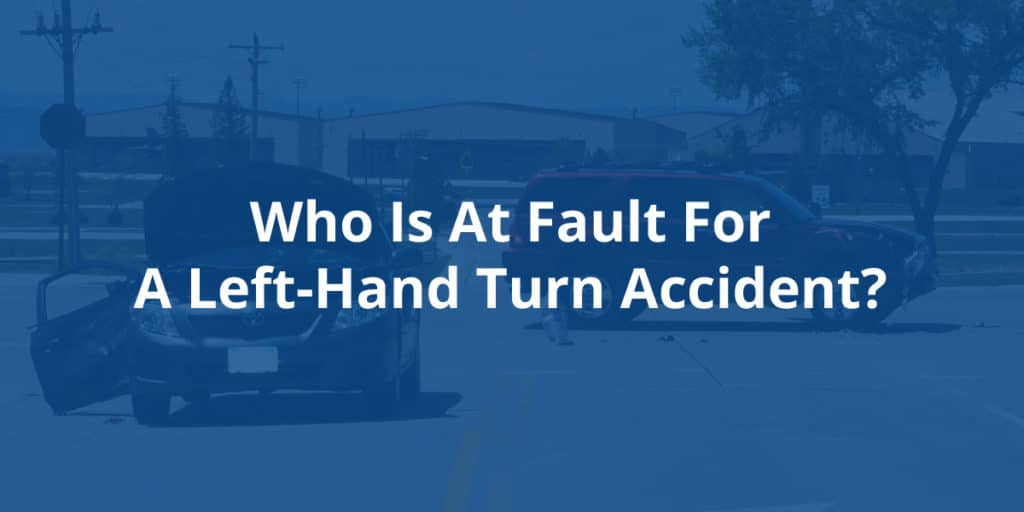
There are always many factors that come into play in terms of determining who’s at fault in a car accident, and when it comes to left-hand turn accidents there tends to be a false assumption that the driver conducting the left-hand turn is always at fault.
Of course this isn’t always the case because all circumstances are different, but there still is a predominant legal misconception within these scenarios because left-hand turns typically require drivers to yield the right of way. It’s always perfectly reasonable to expect drivers making left-hand turns to yield to oncoming traffic, but the liability within some of these types of accidents is sometimes more difficult to determine than most would initially think.
We are proud to support our clients through these confusing personal injury cases, and we fully understand how difficult it can be to prove that the other driver not making a left turn was at fault in these types of scenarios. So what we’ve done in this article is provide you with everything you need to know in terms of determining fault if you find yourself involved in a left-hand turn accident by making the turn or driving straight.
As always, if you have any questions for us don’t hesitate to contact us for a free consultation so we can better understand your case and start making the initial steps towards legal action.
The driver who is trying to make a left-hand turn must always yield to other vehicles, unless the left-turning vehicle has the right of way (green arrow). For the most part, drivers must always properly wait to make left turns until there is no oncoming traffic, or the traffic is at least a safe distance away to allow for the left turn.
It’s also very important for left-turn drivers to remember that they must always wait for cyclists and pedestrians to cross a street or crosswalk safely, but there are some liability differences when a cyclist or pedestrian illegally enters a crosswalk and the driver doesn’t have enough time to stop.
It’s never legal for a left-hand turning driver to cut off oncoming traffic, and this is always a very risky maneuver that does many times lead to collisions. There are many left-hand turn accidents that occur in places where a stoplight isn’t present, and in these places it’s always the responsibility of the left-turning driver to take the necessary precautions before initiating the turn. The oncoming traffic always has the right of way in these situations, which is why left-turning drivers are often initially deemed at fault for these types of accidents.
There are instances in which the left-turning driver isn’t liable for the accident’s occurrence, and this typically is when the driver making the left turn has the right of way. Some examples of this can be when a green left turn arrow is provided, or when a driver runs a red light and impacts the car making the left turn.
Other drivers besides the left-turning driver may be liable for the accident if they are found to be rolling through stop signs, texting and driving, or any other kind of distracted driving. But in legal terms, the liability of these types of accidents will come down to the right of way, each driver’s duties on the road, and what a reasonable and prudent driver would have done in the same type of scenario.
There are also liability situations in which the other driver not making the turn simply was acting negligently or driving recklessly. An example of this would be if the other driver was speeding well over the speed limit and made it difficult for the left-turning driver to gauge the safety of their impending turn.
Unexpected circumstances are always at play when it comes to causing left-turning drivers to swerve or come to a stop while executing their turn, and in certain situations these third parties can be found liable for the accident’s occurrence.
If the other driver going straight was intoxicated or negligent in any way then this could also be a factor in determining at least partial fault for the accident.
No matter which side of the table you’re on in these scenarios, it’s crucial for everyone to know how to prove fault within left-turn accident lawsuits. This can include physical evidence like the debris that’s left on the road after the accident, the resting positions of each vehicle after the crash, and any kind of camera footage that may be helpful in determining the liability of what happened. There’s no doubt about it that collecting this type of evidence is somewhat difficult, especially in more rural areas where traffic cameras aren’t available.
Once any kind of left-hand turn accident occurs, it’s always important to call the police immediately and have them come conduct an official accident report. If you’re capable of doing so, it’s also a good idea to take pictures of the accident scene and your injuries as soon as possible. The timeliness of these pictures is crucial because the police may be required to move the crashed vehicles out of the street, which could potentially destroy valuable evidence that would help your case.
No matter what, you should always reach out to one of our attorneys as soon as possible when you’re involved in a left-hand turn accident. By going through our free consultation process we’ll be able to help determine your best course of legal action and begin building a strategy that will help you prove that the other driver was at fault for the damages done to you and your passengers.
Filed Under: